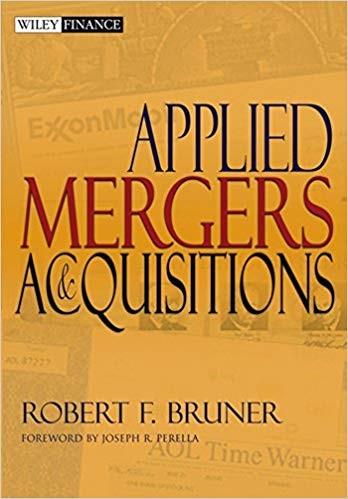(eBook PDF) Case Studies in Finance 8th Edition by Robert
Bruner
install download
https://ebookluna.com/product/ebook-pdf-case-studies-infinance-8th-edition-by-robert-bruner/
Instant digital products (PDF, ePub, MOBI) ready for you
Download now and discover formats that fit your needs...
(eBook PDF) Applied Mergers and Acquisitions by Robert F. Bruner
https://ebookluna.com/product/ebook-pdf-applied-mergers-andacquisitions-by-robert-f-bruner/
ebookluna.com
(eBook PDF) Essential Case Studies in Public Health
https://ebookluna.com/product/ebook-pdf-essential-case-studies-inpublic-health/
ebookluna.com
(eBook PDF) Case Studies In Abnormal Psychology, 10th Edition
https://ebookluna.com/product/ebook-pdf-case-studies-in-abnormalpsychology-10th-edition/
ebookluna.com
(eBook PDF) Business Ethics: Case Studies and Selected Readings 8th Edition
https://ebookluna.com/product/ebook-pdf-business-ethics-case-studiesand-selected-readings-8th-edition/
ebookluna.com
(eBook PDF) Case Studies in Health Information Management 3rd Edition
https://ebookluna.com/product/ebook-pdf-case-studies-in-healthinformation-management-3rd-edition/
ebookluna.com
Case Studies in Social Psychology: Critical Thinking and Application (eBook PDF)
https://ebookluna.com/product/case-studies-in-social-psychologycritical-thinking-and-application-ebook-pdf/
ebookluna.com
(eBook PDF) Case Studies in Forensic Accounting and Fraud Auditing (2nd Edition)
https://ebookluna.com/product/ebook-pdf-case-studies-in-forensicaccounting-and-fraud-auditing-2nd-edition/
ebookluna.com
Case Studies in Geospatial Applications to Groundwater Resources 1st Edition - eBook PDF
https://ebookluna.com/download/case-studies-in-geospatialapplications-to-groundwater-resources-ebook-pdf/
ebookluna.com
Case Studies in Clinical Cardiac Electrophysiology 1st Edition John M. Miller - eBook PDF
https://ebookluna.com/download/case-studies-in-clinical-cardiacelectrophysiology-ebook-pdf/
ebookluna.com
Cornett, Adair, and Nofsinger
M: Finance
Fourth Edition
DeMello
Cases in Finance
Third Edition
Grinblatt (editor)
Stephen A. Ross, Mentor: Influence through Generations
Grinblatt and Titman
Financial Markets and Corporate Strategy
Second Edition
Higgins
Analysis for Financial Management
Twelfth Edition
Ross, Westerfield, Jaffe, and Jordan
Corporate Finance
Eleventh Edition
Ross, Westerfield, Jaffe, and Jordan
Corporate Finance: Core Principles and Applications
Fifth Edition
Ross, Westerfield, and Jordan
Essentials of Corporate Finance
Ninth Edition
Ross, Westerfield, and Jordan
Fundamentals of Corporate Finance
Twelfth Edition
Shefrin
Behavioral Corporate Finance: Decisions that Create Value
Second Edition
INVESTMENTS
Bodie, Kane, and Marcus
Essentials of Investments
Tenth Edition
Bodie, Kane, and Marcus
Investments
Eleventh Edition
Hirt and Block
Fundamentals of Investment Management
Tenth Edition
Jordan, Miller, and Dolvin
Fundamentals of Investments: Valuation and Management
Eighth Edition
Stewart, Piros, and Heisler
Running Money: Professional Portfolio Management
First Edition
Sundaram and Das
Derivatives: Principles and Practice
Second Edition
Financial Institutions and Markets
Rose and Hudgins
Bank Management and Financial Services
Ninth Edition
Rose and Marquis
Financial Institutions and Markets
Eleventh Edition
Saunders and Cornett
Page iv
Financial Institutions Management: A Risk Management Approach
Ninth Edition
Saunders and Cornett
Financial Markets and Institutions
Seventh Edition
INTERNATIONAL FINANCE
Eun and Resnick
International Financial Management
Eighth Edition
REAL ESTATE
Brueggeman and Fisher
Real Estate Finance and Investments
Sixteenth Edition
Ling and Archer
Real Estate Principles: A Value Approach
Fifth Edition
Financial Planning and Insurance
Allen, Melone, Rosenbloom, and Mahoney
Retirement Plans: 401(k)s, IRAs, and Other Deferred Compensation Approaches
Tenth Edition
Altfest
Personal Financial Planning
Second Edition
Harrington and Niehaus
Risk Management and Insurance
Second Edition
Kapoor, Dlabay, Hughes, and Hart
Focus on Personal Finance: An active approach to help you achieve financial literacy
Sixth Edition
Kapoor, Dlabay, Hughes, and Hart
Personal Finance
Twelfth Edition
Walker and Walker
Personal Finance: Building Your Future
Second Edition
About the Authors
Robert F. Bruner is University Professor, Distinguished Professor of Business Administration and Charles C. Abbott Professor of Business Administration and Dean Emeritus of the Darden Graduate School of Business Administration at the University of Virginia. He has taught and written in various areas, including corporate finance, mergers and acquisitions, investing in emerging markets, innovation, and technology transfer. In addition to Case Studies in Finance, his books include Finance Interactive, multimedia tutorial software in Finance (Irwin/McGraw-Hill 1997), The Portable MBA (Wiley 2003), Applied Mergers and Acquisitions, (Wiley, 2004), Deals from Hell: M&A Lessons that Rise Above the Ashes (Wiley, 2005) and The Panic of 1907 (Wiley, 2007). He has been recognized in the United States and Europe for his teaching and case writing. BusinessWeek magazine cited him as one of the “masters of the MBA classroom.” He is the author or co-author of over 400 case studies and notes. His research has been published in journals such as Financial Management, Journal of Accounting and Economics, Journal of Applied Corporate Finance, Journal of Financial Economics, Journal of Financial and Quantitative Analysis, and Journal of Money, Credit, and Banking. Industrial corporations, financial institutions, and government agencies have retained him for counsel and training. He has been on the faculty of the Darden School since 1982, and has been a visiting professor at Harvard, Columbia, INSEAD, and IESE. Formerly he was a loan officer and investment analyst for First Chicago Corporation. He holds the B.A. degree from Yale
Page vii University and the M.B.A. and D.B.A. degrees from Harvard University. Copies of his papers and essays may be obtained from his website, http://www.darden.virginia.edu/web/Faculty-Research/Directory/Full-time/Robert-F-Brun He may be reached via email at brunerr@virginia.edu.
Kenneth M. Eades is Professor of Business Administration and Area Coordinator of the Finance Department of the Darden Graduate School of Business Administration at the University of Virginia. He has taught a variety of corporate finance topics including: capital structure, dividend policy, risk management, capital investments and firm valuation. His research interests are in the area of corporate finance where he has published articles in The Journal of Finance, Journal of Financial Economics, Journal of Financial and Quantitative Analysis, and Financial Management. In addition to Case Studies in Finance, his books include The Portable MBA (Wiley 2010) Finance Interactive, a multimedia tutorial software in Finance (Irwin/McGraw-Hill 1997) and Case Studies in Financial Decision Making (Dryden Press, 1994). He has authored or co-authored over 70 case studies as well as a web-based, interactive tutorial on the pricing of financial derivatives. He has received the Wachovia Award for Excellence in Teaching Materials and the Wachovia Award for Excellence in Research. Mr. Eades is active in executive education programs at the Darden School and has served as a consultant to a number of corporations and institutions; including many commercial banks and investment banks; Fortune 500 companies and the Internal Revenue Service. Prior to joining Darden in 1988, Professor Eades was a member of the faculties at The University of Michigan and the Kellogg School of Management at Northwestern University. He has a B.S. from the University of Kentucky and Ph.D. from Purdue University. His website is
http://www.darden.virginia.edu/web/Faculty-Research/Directory/Full-time/Kenneth-M-Ea and he may be reached via email at eades@virginia.edu.
Michael J. Schill is Professor of Business Administration of the Darden Graduate School of Business Administration at the University of Virginia where he teaches corporate finance and investments. His research spans empirical questions in corporate finance, investments, and international finance. He is the author of numerous articles that have been published in leading finance journals such as Journal of Business, Journal of Finance, Journal of Financial Economics, and Review of Financial Studies, and cited by major media outlets such as The Wall Street Journal. He has been on the faculty of the Darden School since 2001 and was previously with the University of California, Riverside, as well as a visiting professor at Cambridge and Melbourne. He is the current course head for Darden’s core MBA finance course. He is the author or co-author of over 40 cases and technical notes, as well as a financial market simulation entitled Bond Trader. Prior to his doctoral work, he was a consultant with Marakon Associates in Stamford and London. He received a B.S. degree from Brigham Young University, an M.B.A. from INSEAD, and a Ph.D. from University of Washington. More details are available from his website, http://www.darden.virginia.edu/web/Faculty-Research/Directory/Full-time/Michael-J-Sch He may be reached via email at schill@virginia.edu.

Foreword
As I think about developing the next generation of leaders in business and finance, I naturally reflect on my own path. My career in business has taught some profound lessons and so did my experience at the University of Virginia’s Darden School of Business. Both life experience and school learning are critical components in the development of any leader. For that reason, I have supported wholeheartedly higher education as the path toward a promising future.
As the world keeps changing, higher education must continually adapt. Practices, processes, and business models that were once popular have faded. At the same time, the field of Finance has witnessed dramatic changes, including the advent of new valuation models, the rise of new markets and institutions, the invention of new financial instruments, the impact of new information technologies, and growing globalization. In this environment, we must think critically about the changing world, pay attention to new ideas, and adapt in sensible ways. Business schools play a critical role in the change process: theory suggests new approaches, empirical research tests them, and classroom teaching transfers knowledge. The development of new teaching materials is vital to that process.
Case studies in Finance have evolved markedly over the past 40 years. This shift reflects the revolutionary changes in markets and organization, as well as the many significant advances in theory and empirical research. Because case studies are an invaluable teaching tool, it is critical that the
body of cases grows with the practice of and scholarship in Finance.
I am pleased to introduce the reader to the eighth edition of Case Studies in Finance, by Robert F. Bruner, Kenneth M. Eades, and Michael J. Schill. These professors exemplify the practice-oriented scholar who understands the economic foundations of Finance and the extensive varieties of its practice. They translate business phenomena into material that is accessible both to experienced practitioners and novices in Finance.
This book is a valuable contribution to the teaching materials available in the field of Finance. First, these cases link managerial decisions to capital markets and investor expectations. At the core of most is a valuation task that requires students to look to financial markets to resolve the problem. Second, these cases feature a wide range of contemporary and relevant problems, including examples in real and financial options, agency conflicts, financial innovation, investing in emerging markets, and corporate control. They also cover classic topics in Finance, including dividend policy, the mix of debt and equity financing, the estimation of future financial requirements, and the choice between mutually exclusive investments. Finally, these cases invite students to harness technology they will use in the workplace to develop key insights.
I am confident this collection will help students, scholars, and practitioners sharpen their decision-making ability, and advance the development of the next generation of leaders in Finance.
John R. Strangfeld Chairman and Chief Executive Officer
Prudential Financial, Inc.
May 3, 2017
Newark, New Jersey
Preface
The inexplicable is all around us. So is the incomprehensible. So is the unintelligible. Interviewing Babe Ruth in 1928, I put it to him “People come and ask what’s your system for hitting home runs that so?” “Yes,” said the Babe, “and all I can tell ‘em is I pick a good one and sock it I get back to the dugout and they ask me what it was I hit and I tell ` em I don’t know except it looked good.”
Carl Sandburg
Managers are not confronted with problems that are independent of each other, but with dynamic situations that consist of complex systems of changing problems that interact with each other. I call such situations messes . . . Managers do not solve problems: they manage messes.
Russell Ackoff
Orientation of the Book
Practitioners tell us that much in finance is inexplicable, incomprehensible, and unintelligible. Like Babe Ruth, their explanations for their actions often amount to “I pick a good one and sock it.” Fortunately for a rising generation of practitioners, tools and concepts of Modern Finance provide a language and approach for excellent performance. The aim of this book is to illustrate and exercise the application of these tools and concepts in a messy world.
Focus on Value
The subtitle of this book is Managing for Corporate Value Creation. Economics teaches us that value creation should be an enduring focus of
Linkage to Capital Markets
Page xiii concern because value is the foundation of survival and prosperity of the enterprise. The focus on value also helps managers understand the impact of the firm on the world around it. These cases harness and exercise this economic view of the firm. It is the special province of finance to highlight value as a legitimate concern for managers. The cases in this book exercise valuation analysis over a wide range of assets, debt, equities, and options, and a wide range of perspectives, such as investor, creditor, and manager.
An important premise of these cases is that managers should take cues from the capital markets. The cases in this volume help the student learn to look at the capital markets in four ways. First, they illustrate important players in the capital markets such as individual exemplar Warren Buffett and institutions like investment banks, commercial banks, rating agencies, hedge funds, merger arbitrageurs, private equity firms, lessors of industrial equipment, and so on. Second, they exercise the students’ abilities to interpret capital market conditions across the economic cycle. Third, they explore the design of financial securities, and illuminate the use of exotic instruments in support of corporate policy. Finally, they help students understand the implications of transparency of the firm to investors, and the impact of news about the firm in an efficient market.
Respect for the Administrative Point of View
The real world is messy. Information is incomplete, arrives late, or is reported with error. The motivations of counterparties are ambiguous. Resources often fall short. These cases illustrate the immense practicality of finance theory in sorting out the issues facing managers, assessing alternatives, and illuminating the effects of any particular choice. A number of the cases in this
book present practical ethical dilemmas or moral hazards facing managers indeed, this edition features a chapter, “Ethics in Finance” right at the beginning, where ethics belongs. Most of the cases (and teaching plans in the associated instructor’s manual) call for action plans rather than mere analyses or descriptions of a problem.
Contemporaneity and Diversity
All of the cases in this book are set in the year 2006 or after and 25 percent are set in 2015 or later. A substantial proportion (57 percent) of the cases and technical notes are new, or significantly updated. The mix of cases reflects the global business environment: 52 percent of the cases in this book are set outside the United States, or have strong cross-border elements. Finally the blend of cases continues to reflect the growing role of women in managerial ranks: 31 percent of the cases present women as key protagonists and decision-makers. Generally, these cases reflect the increasingly diverse world of business participants.
Plan of the Book
The cases may be taught in many different combinations. The sequence indicated by the table of contents corresponds to course designs used at Darden. Each cluster of cases in the Table of Contents suggests a concept module, with a particular orientation.
1. Setting Some Themes. These cases introduce basic concepts of value creation, assessment of performance against a capital market benchmark, and capital market efficiency that reappear throughout a case course. The numerical analysis required of the student is relatively light. The synthesis of case facts into an important framework or perspective is the main challenge. The case, “Warren















